Ships from: Keavy, KY, USA
1 Live Jerusalem Sunchoke Artichoke Seedling
1 Live Jerusalem Sunchoke Artichoke Seedling
Couldn't load pickup availability
Grow your own patch of edible abundance with a Live Jerusalem Sunchoke (Artichoke) Seedling. Also known as sunroot, topinambur, or earth apple, this hardy perennial produces knobby, nutty-sweet tubers perfect for roasting, soups, and fermenting.
Unlike globe artichokes, Jerusalem artichokes are in the sunflower family—sending up tall, cheerful yellow blooms while developing a network of delicious underground tubers. Plant once, and enjoy years of harvest from a single clump. Ideal for food forests, permaculture beds, or low-maintenance edible landscapes.
🌟 Product Highlights:
✅ Live seedling – ready to plant
✅ Produces edible, high-yield tubers in 90–120 days
✅ Tolerates drought and poor soil
✅ Hardy in USDA Zones 3–9
✅ Beautiful sunflowers attract bees and beneficial insects
✅ Fast-spreading perennial—returns annually
🌿 Growing Tips:
-
Planting Location: Full sun, with room to spread
-
Soil: Loamy or sandy, but tolerates clay—just loosen well
-
Spacing: Plant 12–18 inches apart, 2–3 feet between rows
-
Watering: Moderate water—drought-tolerant once established
-
Harvest: Dig tubers after frost dies back foliage in fall
-
Storage: Store tubers in cool, moist sand or leave in-ground and dig as needed
- Control: Contain roots if spread is a concern—can naturalize rapidly
❓ FAQ – Live Jerusalem Sunchoke Seedling
Are Jerusalem artichokes the same as regular artichokes?
No. Jerusalem sunchokes are in the sunflower family and grown for their tubers, not flower buds.
Will it survive winter?
Yes—this plant is hardy in Zones 3–9 and returns every spring.
How long until I can harvest?
Tubers mature in about 90–120 days. Best harvested after the first frost for sweeter flavor.
Can I grow this in containers?
Large containers (15–20+ gallons) can work, but in-ground planting yields the best results.
How do I control its spread?
Harvest thoroughly each year, or plant in buried containers or raised beds with root barriers.
Share


